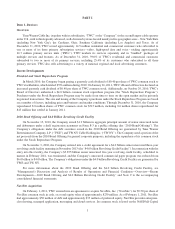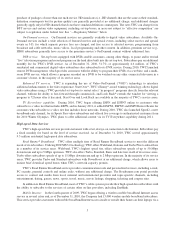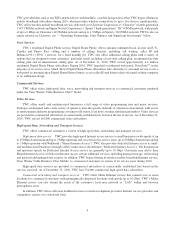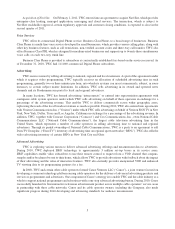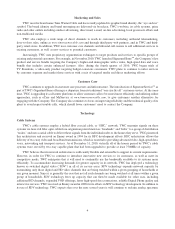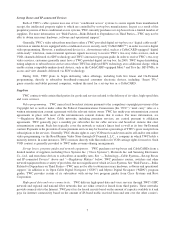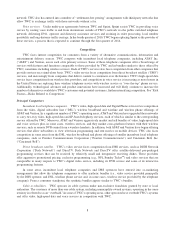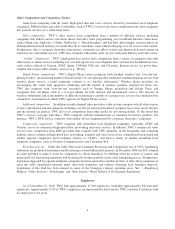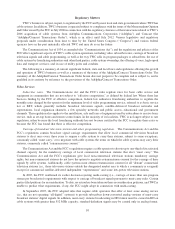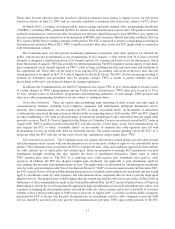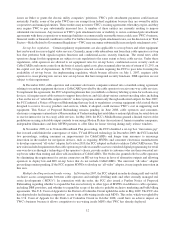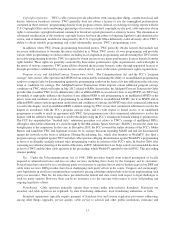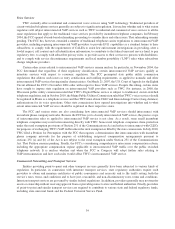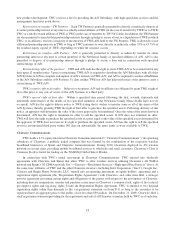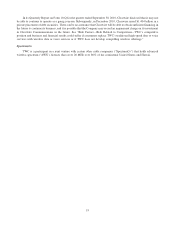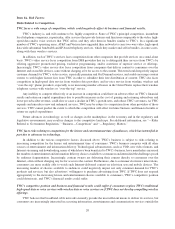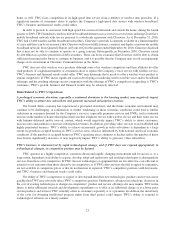Time Warner Cable 2010 Annual Report Download - page 23
Download and view the complete annual report
Please find page 23 of the 2010 Time Warner Cable annual report below. You can navigate through the pages in the report by either clicking on the pages listed below, or by using the keyword search tool below to find specific information within the annual report.These rules became effective after the broadcast television transition from analog to digital service for full power
television stations on June 12, 2009, and are currently scheduled to terminate after three years, subject to FCC review.
In March 2010, a coalition of fourteen public interest groups and multi-channel video programming distributors
(“MVPDs”), including TWC, petitioned the FCC for reform of the retransmission consent rules. The petition stated that
outdated retransmission consent rules allow broadcasters to threaten signal blackouts to force MVPDs to pay significant
increases in retransmission consent fees to the detriment of MVPDs and consumers. Shortly thereafter, in March 2010, the
FCC issued a Public Notice seeking comment on the petition. The FCC is expected to initiate a rulemaking proceeding on
retransmission consent in March 2011. TWC is unable to predict what rules, if any, the FCC might adopt in connection
with retransmission consent.
The Communications Act also permits franchising authorities to negotiate with cable operators for channels for
public, educational and governmental access programming. It also requires a cable system with 36 or more activated
channels to designate a significant portion of its channel capacity for commercial leased access by third parties, which
limits the amount of capacity TWC has available for other programming. The FCC regulates various aspects of such third-
party commercial use of channel capacity on TWC’s cable systems, including the rates and some terms and conditions of
the commercial use. These rules are the subject of an ongoing FCC proceeding, and recent revisions to such rules are
stayed pursuant to an appeal in the U.S. Court of Appeals for the Sixth Circuit. The FCC also has an open proceeding to
examine its substantive and procedural rules for program carriage. TWC is unable to predict whether any such
proceedings will lead to any material changes in existing regulations.
In addition, the Communications Act and FCC regulations also require TWC to give various kinds of advance notice
of certain changes in TWC’s programming line-up. Under certain circumstances, TWC must give as much as 30 or
45 days’ advance notice to subscribers, programmers and franchising authorities of such changes. DBS operators and
other non-cable programming distributors are not subject to analogous duties.
Ownership limitations. There are various rules prohibiting joint ownership of cable systems and other kinds of
communications facilities, including local telephone companies and multichannel multipoint distribution service
facilities. The Communications Act also requires the FCC to adopt “reasonable limits” on the number of subscribers
a cable operator may reach through systems in which it holds an ownership interest. In December 2007, the FCC adopted
an order establishing a 30% limit on the percentage of nationwide multichannel video subscribers that any single cable
provider can serve. The U.S. Court of Appeals for the District of Columbia Circuit reversed and vacated the FCC order in
August 2009. TWC is unable to predict when the FCC will take action to set new limits, if any. The Communications Act
also requires the FCC to adopt “reasonable limits” on the number of channels that cable operators may fill with
programming services in which they hold an ownership interest. The matter remains pending before the FCC. It is
uncertain when the FCC will rule on this issue or how any regulation it adopts might affect TWC.
Pole attachment regulation. The Communications Act requires that investor-owned utilities provide cable systems
and telecommunications carriers with non-discriminatory access to any pole, conduit or right-of-way controlled by those
utilities. The Communications Act permits the FCC to regulate the rates, terms and conditions imposed by these utilities
for cable systems’ use of utility poles and conduit space. States are permitted to preempt FCC jurisdiction over pole
attachments through certifying that they regulate the terms of attachments themselves. Many states in which
TWC operates have done so. The FCC or a certifying state could increase pole attachment rates paid by cable
operators. In addition, the FCC has adopted a higher pole attachment rate applicable to pole attachments made by
any company that provides telecommunications services. The applicability of and method for calculating pole attachment
rates for cable operators that provide Voice Over Internet Protocol (“VoIP”) services remains unclear. In November 2007,
the FCC issued a Notice of Proposed Rulemaking that proposes to establish a new unified pole attachment rate that would
apply to attachments made by cable operators and telecommunications companies that are used to provide high-speed
Internet services. The proposed rate could be higher than the current rate paid by cable service providers. In May 2010, in
furtherance of the recommendations made in the National Broadband Plan, the FCC issued a Further Notice of Proposed
Rulemaking to refresh the record regarding the appropriate high-speed Internet service pole attachment rates and to seek
comment on bringing the telecommunications rate and the cable rate closer to parity and as low as possible. It is unclear
whether or how a ruling would apply to VoIP services; however, in August 2009, a coalition of electric utility companies
petitioned the FCC to declare that the pole attachment rate for attachments used by cable companies to provide VoIP
services should be assessed at the rate paid by telecommunications providers. TWC opposed this petition. If the FCC
11


